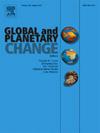Eccentricity pacing of the Paleocene-Eocene Thermal Maximum: Multi-section astrochronology and statistical insights in China
IF 4
1区 地球科学
Q1 GEOGRAPHY, PHYSICAL
引用次数: 0
Abstract
The Paleocene-Eocene Thermal Maximum (PETM; ∼56 Ma) is marked by a significant negative carbon isotope excursion (CIE) and represents an intense global warming over a geologically brief time. A high-resolution chronologic framework is essential for understanding the tempo and triggers of carbon releases during the PETM. In this study, we constructed independent astrochronologic frameworks for the PETM using three high-resolution proxy records from the Fushun, Nanyang, and Tarim basins in China. By integrating statistical methods, including TimeOpt and Bayesian statistics, we identified statistically significant orbital signals and assessed age uncertainties. Our results indicate a synchronized marine and terrestrial carbon cycle perturbation during the PETM. The main body of the CIE lasted ∼100 kyr, with the onset ranging from ∼5 to 20 kyr. The spectral power of orbital eccentricity increased near the PETM onset, suggesting that astronomical forcing may have triggered the PETM. Additionally, two smaller carbon isotope excursions were identified before and after the PETM onset in some records, potentially coinciding with ∼100 kyr short eccentricity maxima, further supporting the eccentricity pacing of carbon cycles during this crucial climatic transition.
求助全文
约1分钟内获得全文
求助全文
来源期刊

Global and Planetary Change
地学天文-地球科学综合
CiteScore
7.40
自引率
10.30%
发文量
226
审稿时长
63 days
期刊介绍:
The objective of the journal Global and Planetary Change is to provide a multi-disciplinary overview of the processes taking place in the Earth System and involved in planetary change over time. The journal focuses on records of the past and current state of the earth system, and future scenarios , and their link to global environmental change. Regional or process-oriented studies are welcome if they discuss global implications. Topics include, but are not limited to, changes in the dynamics and composition of the atmosphere, oceans and cryosphere, as well as climate change, sea level variation, observations/modelling of Earth processes from deep to (near-)surface and their coupling, global ecology, biogeography and the resilience/thresholds in ecosystems.
Key criteria for the consideration of manuscripts are (a) the relevance for the global scientific community and/or (b) the wider implications for global scale problems, preferably combined with (c) having a significance beyond a single discipline. A clear focus on key processes associated with planetary scale change is strongly encouraged.
Manuscripts can be submitted as either research contributions or as a review article. Every effort should be made towards the presentation of research outcomes in an understandable way for a broad readership.
 求助内容:
求助内容: 应助结果提醒方式:
应助结果提醒方式:


